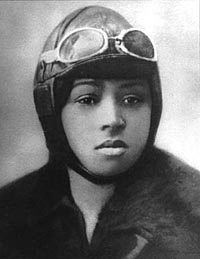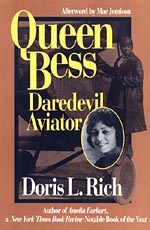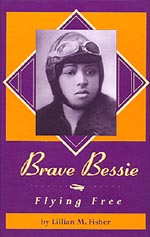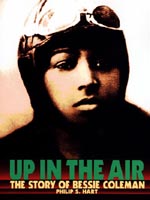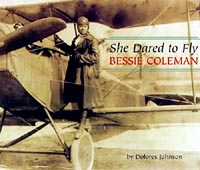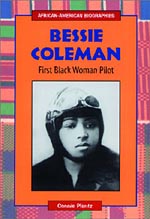
Elizabeth 'Bessie' Coleman (1893-1926)
Bessie Coleman was born on January 26, 1893 in Atlanta, Texas. In pursuing a flying career, she had three goals: earn a pilot's license; become a recognized stunt and exhibition flier; and establish an aviation school for Blacks. Rejected by every American aviation school she applied to, she was encouraged by Robert S. Abbott (founder of the Chicago Defender) to study abroad.
Barnstorming across the country, she thrilled thousands as "Brave Bessie". On April 30, 1936, while making a practice run with her mechanic as the pilot, Bessie Coleman was thrown out of the plane when the controls jammed. A Pioneer in the field of aviation, her story became the inspiration for other Blacks to take to the skies.
 Bessie Coleman, c.1922 download a 1000pixel Mono or Sepia image
Bessie Coleman: First internationally licensed woman pilot On June 15, 1921 Bessie Coleman became the first African-American woman to earn a aviation pilot's license in the world - and the first African-American woman to earn an international aviation license from the from the Federation Aeronautique Internationale.
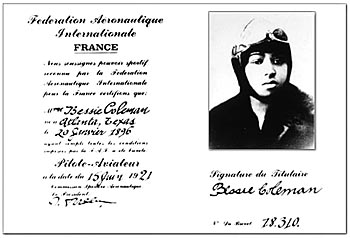 Bessie Coleman, Pilots Licence, 1921
Smithsonian Institution, Neg. ID #: 99-15416 used with permission
A native of Texas, she went to France to get her pilot's license because of the bigotry of those in U.S. aviation who opposed her training because she was a woman and because she was black. No black U.S. aviator would train her either.
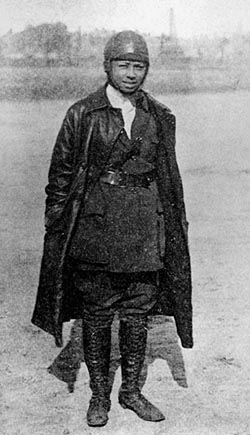 Bessie Coleman around the time of her French visit, c.1922
Smithsonian Institution, Neg. ID #: 99-15415 used with permission
A native of Texas, Coleman learned to speak French and saved enough money to go to France. It was not simple but she got through it and fulfilled her dream of flying. On her return to the U.S. Coleman opened a flight school in Chicago and taught other black women to fly as well as doing the usual (for the time) barnstorming in air circuses to keep flying. "Queen Bessie," as she was known was a highly popular draw for the next 15 years. However, on April 30, 1936, while practicing for a show in Orlando, Fla., the controls on her plane jammed and her plane crashed to the ground killing her instantly. [she had fallen out -Ed.]
Bessie Coleman (1892-1926) Known to an admiring public as "Queen Bess," Bessie Coleman was the first black woman ever to fly an airplane and the first African American to earn an international pilot's license. During her brief yet distinguished career as a performance flier, she appeared at air shows and exhibitions across the United States, earning wide recognition for her aerial skill, her dramatic flair, and her tenacity. But the thrill of stunt flying and the admiration of cheering crowds were only part of Coleman's dream. Forced for a time to work as a laundress and manicurist to make ends meet, Coleman never lost sight of her childhood vow to one day "amount to something." As a professional aviatrix, Coleman would often be criticized by the press for her opportunistic nature and the flamboyant style she brought to her exhibition flying. However, she also quickly gained a reputation as a skilled and daring pilot who would stop at nothing to complete a difficult stunt. Unfortunately, Coleman would not live long enough to fulfill her greatest dream-establishing a school for young, black aviators-but her pioneering achievements served as an inspiration for a generation of African American men and women. "Because of Bessie Coleman," wrote Lieutenant William J. Powell in Black Wings, "we have overcome that which was worse than racial barriers. We have overcome the barriers within ourselves and dared to dream." ...more
People & Events Bessie Coleman (1892 -1926) Bessie Coleman, the first African American female pilot, grew up in a cruel world of poverty and discrimination. The year after her birth in Atlanta, Texas, an African American man was tortured and then burned to death in nearby Paris for allegedly raping a five-year-old girl. The incident was not unusual; lynchings were endemic throughout the South. African Americans were essentially barred from voting by literacy tests. They couldn't ride in railway cars with white people, or use a wide range of public facilities set aside for whites. When young Bessie first went to school at the age of six, it was to a one-room wooden shack, a four-mile walk from her home. Often there wasn't paper to write on or pencils to write with. ...more
Bessie Coleman (1892-1926) Bessie Coleman (Brave Bessie or Queen Bess), the world's first licensed black pilot, daughter of Susan Coleman, was born in Atlanta, Texas, on January 26, 1892, the twelfth of thirteen children. She grew up in Waxahachie. Her father left the family in 1900 to return to Indian Territory. Bessie, along with several siblings still living at home, helped ease the family's financial troubles by picking cotton or assisting with the washing and ironing that her mother took in. Upon graduation from high school she enrolled at the Colored Agricultural and Normal University (now Langston University) in Langston, Oklahoma. Financial difficulties, however, forced her quit after one semester. She moved to Chicago, where a brother was then living, and attended beauty school for a time. She spent the early years of World War Iqv working as a manicurist at the White Sox Barbershop. She then operated a small but profitable chili parlor. Apparently in early 1917 Bessie Coleman married Claude Glenn, but she never publicly acknowledged the marriage, and the two soon separated.
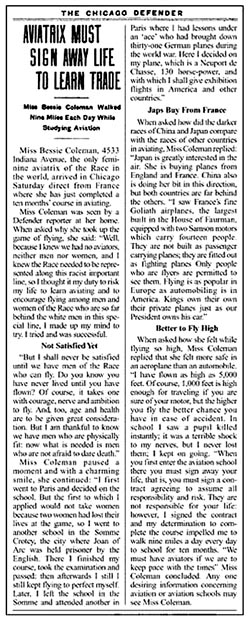
Bessie Coleman News Item
Image ex Library of Congress, Newspaper and Periodicals Division used with permission
In 1920 Coleman, acting on a lifelong dream of learning to fly, traveled abroad to attend (the Caudron Brothers) aviation school in Le Crotoy, France, after she discovered that no American school would accept African Americans.qv Robert S. Abbott, editor of the Chicago Weekly Defender, assisted her in contacting schools abroad.
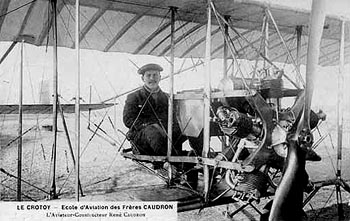 René Caudron, 'Ecole d'Aviation', Le Crotoy, France
After studying for ten months in France she was issued a license on June 15, 1921, by the Fédération Aéronautique Internationale, giving her the distinction of being the first black person in the world to become a licensed pilot. ...more however, the article concludes... Over the years, recognition of Coleman's accomplishments has grown. In 1977 a group of black female student pilots in Indiana organized the Bessie Coleman Aviators Club. In 1990 a street in Chicago was renamed Bessie Coleman Drive, and May 2, 1992, was declared Bessie Coleman Day in Chicago. In 1995 (1994? - Ed) the United States Postal Service issued a thirty-two-cent commemorative stamp in her honor.
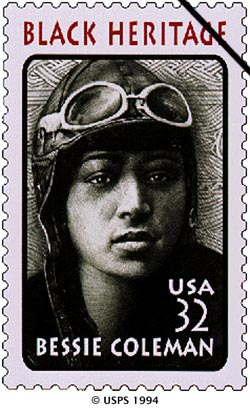 Bessie Coleman, 1994
BIBLIOGRAPHY: Austin American-Statesman, September 6, 1993. Roger Bilstein and Jay Miller, Aviation in Texas (Austin: Texas Monthly Press, 1985). Dallas Morning News, September 8, 1993. Houston Post-Dispatch, May 1, 1926. Anita King, "Brave Bessie: First Black Pilot," Parts 1 and 2, Essence, May, June 1976. Doris L. Rich, Queen Bess: Daredevil Aviator (Washington: Smithsonian Institution Press, 1993). Vertical Files, Barker Texas History Center, University of Texas at Austin. Roni Morales
Above the Cotton Fields: The Bessie Coleman Story This article appeared in the October 1990 issue of Code One Magazine Labor Day Weekend, 1922. Clear skies, mild temperatures, and the promise of a show that had already been postponed once because of bad weather. A record crowd gathered that Sunday at Curtiss Field near Manhattan to see the latest craze in public spectacles - stunt fliers - do their thing. They would, as publicists had been screaming for days - "risk their lives in the skies before your very eyes." With imaginations stirred by the very thought of flight, many had come to see the much-ballyhooed show. This particular show, however, would be special. It would feature that rarest form of the stunt flyer known to man, a woman. And if, as many believed, it was unnatural for man to fly, they fully expected to see a perversion beyond comprehension, with God-only-knows what consequences. Bessie Coleman, star attraction, was just one of hundreds of high-spirited young fliers in those early days whose names have been obscured by such greats as Wright, Thibaud, Beachey, Fokker, Curtiss, Quimby, and Meyers. They flew surplus World War I (Curtiss) Jennies and DeHavilands, which could be bought for $200 and held together with bailing wire and glue.
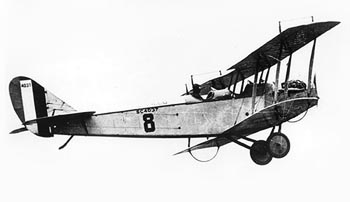 Curtiss Jenny JN4
Smithsonian Institution, Neg. ID #: 86-6177 used with permission download a 750pixel image
They flew the countryside in the wake of carnivals and fairs, trying to earn a living doing what they loved most. They landed in farmers' fields and slept in barns. They attracted crowds with their aerial acrobatics, wing-walking, parachuting, and diving. Then they passed the hat and offered short rides for a fee. There weren't many jobs in aviation then, and a man (or a woman) had to do what a man (or a woman) had to do. Coleman was right smack in the middle of it all, but her name is little known or remembered today....more
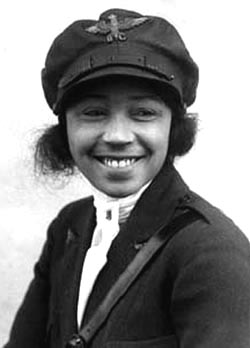 Bessie Coleman, c.1920
Further Reading : Online
Bessie Coleman (1893-1926)
Black Wings : Early Pioneers Inspire Blacks to Become Pilots
Further Reading : In Print Adult
Young Readers
|
© Copyright 1999-2003 CTIE - All Rights Reserved - Caution |
